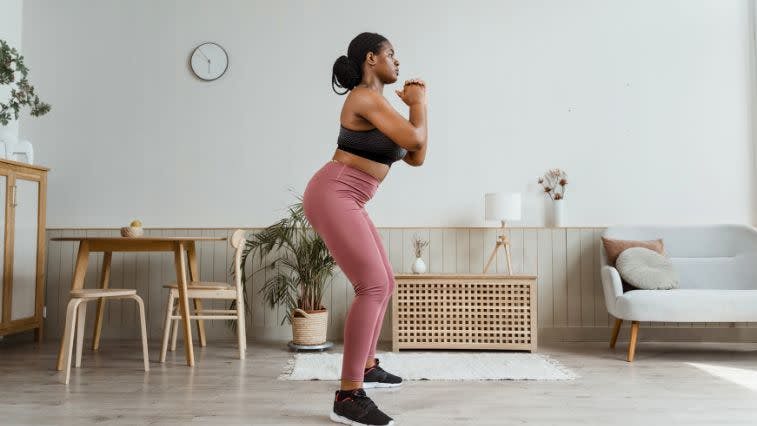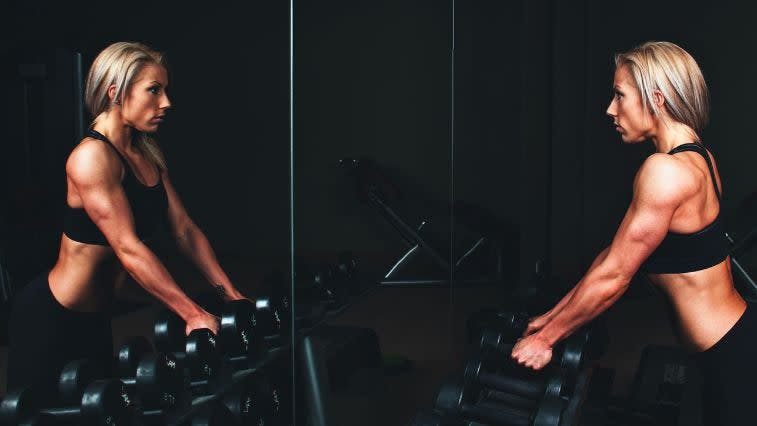How Much Weight Should I Lift When I'm New to Strength Training?
A certified personal trainer tells you how to decide
Our content strives to support, inform, and motivate you to meet your health goals. We want to be your trusted source of expert- and science-backed info dispensed in simple, actionable ways. Read our Editorial Guidelines.
Are you ready to start weightlifting but don’t know where or how to begin? You’re not alone! We’ve all been there, from experienced lifters to beginners just getting started. But that doesn't have to stop you. A key place to start is knowing what weight you should use for each exercise.
Starting a weightlifting routine can be as daunting as driving for the first time.
You’ll face one of every new weightlifter’s biggest fears: not knowing how you’ll stack up to other lifters who spend all their leisure time in the gym. You know, the ones who pound a protein shake mid-set between grunting and pumping out biceps curls.
From figuring out which exercises to do, to how much weight to lift, to getting the form right, and lifting next to a total gym bro, it’s easy to feel overwhelmed. But we’ve all been there before (even a personal trainer like myself). So trust me when I say don’t let this — or the fear of looking silly in the gym — stop you from achieving your fitness goals.
In this article, I’ll go over everything you need to know as a beginner so that you can start lifting weights with confidence. These tips and tricks have worked wonders for the dozens of people I’ve coached online (many of whom were beginners just like you).
Factors to Consider When Picking a Weight
Before diving into what weight you should use, we should cover some ground rules.
1.Start with your goal
The first thing I review with clients is their main goal. You won’t know what equipment or weight to use if you don’t know what your goal is in the first place. For example, my client Randy wants a more muscular chest and shoulders. So he’ll want to focus on movements that target these areas.
2. What equipment do you have access to?
After I learn my client’s goal, I need to know what equipment they have. Some of my clients, such as Randy, work out in a commercial gym and have access to much more equipment, including dumbbells, barbells, machines, etc. On the other hand, I have clients working out at home who only have dumbbells, a bench, and resistance bands. Knowing what equipment you have available will help you or your coach determine a good starting weight.
Common Mistakes to Avoid When Starting
Not including a proper warm-up
Now that you have a clear vision of your goal and the equipment you can access, it’s time to get into the fun part: lifting weights! Before you lift anything, you should go through a proper warm-up.
Randy starts his workouts with five minutes of light cardio before touching a weight. This gets his blood pumping and increases his muscle temperature, improving his workout performance and preventing injury. Then, Randy will warm up with lighter weights before getting into his “real sets,” the working sets that count.
Using lighter weights before diving into your working sets will further prime your muscles. Start with lighter weight, about 50% of what you’ll be using (which we’ll cover how to figure out below), and do a set of 10 reps. Then you can do another set with fewer reps (five to eight reps) with a weight about 70% of your lifting weight.
Starting too Heavy
Another typical mistake my clients make when starting a weightlifting routine is beginning with a weight that’s too heavy. Of course, you always want to err on the cautious side and start with light weights before attempting heavier loads. Using too much weight initially will only risk injury, which we want to avoid like the plague.
Not Doing Beginner-friendly Exercises

When you’re trying to decide what weight to use, start with beginner-friendly exercises. For instance, Randy struggles with performing dumbbell lunges so I had Randy start with bodyweight static lunges. Our goal is to progress to dumbbell lunges in the future.
Starting with lunges that aren’t as challenging will yield Randy much more progress than if he began with dumbbell lunges and performed them incorrectly, which could lead to injury and not correctly engaging his leg muscles.
It’s essential to focus on beginner compound exercises that work multiple muscle groups simultaneously, like squats, instead of isolation movements like dumbbell curls. Beginners can see much muscle growth through compound (multi-joint) movements that target multiple and larger muscle groups.
Focusing too much on isolation exercises that target your secondary muscles (triceps and biceps, for example) could hinder your progress. One study found that even half-squats require substantially more energy output than bicep curls. The more exertion a movement spawns, the more muscle you build and calories you burn.
Some whole-body beginner exercises I have my clients start with include:
Bodyweight squats (targets legs)
Machine bench press (targets chest muscles)
Resistance band row (engages your back)
I have all my beginner clients begin with their bodyweight, machines, or resistance bands before incorporating free weights (dumbbells and barbells). These are excellent places to start for beginners since they’re safer than free weights, and allow you to work on your form while minimizing the risk of injury.
After about six to eight weight weeks, when I move my beginners to free weights, I have them stick to light dumbbells. They avoid barbells until they’re intermediate lifters, which can take a few months of lifting consistently, since intermediate-level exercises require more technique.
What Weight Should I Start With?
Now that you know your goal, the common mistakes to avoid, your available equipment, and some exercises, we can discuss what weight to use. The amount of weight you lift will depend on multiple factors, including age, gender, and weight.
For example, most of my male clients are generally stronger than the women I work with so I start them with heavier weights.
The best way to find your starting weight is to start light and work up to the heaviest weight you can lift (with good form). My clients begin by using their body weight, or light weights via machines, bands, or dumbbells that weigh no more than 5–10 pounds so they can perfect their form and test their strength. Then, they gradually increase the weight until they reach a weight that is the max they can do for 10 reps.
Randy started his chest workout program using the lightest weight on the machine bench press and performed reps of 10. After that, he gradually increased his weight until he found the maximum weight he could lift with good form. He started with that weight in his next workout (after warm-up sets).
Beginners can expect to see significant improvements after a few months. A study of 52 obese men reported a 7.5 kg reduction in weight after three months of exercise alone. My clients generally start seeing noticeable improvements in their body composition within six to eight weeks of working out.
Remember that safety comes first when lifting weights. Don't try to lift too much too soon!
When to Use Heavier Weight

Some movements are better suited for heavier weights. Compound movements, such as a machine bench press, will allow you to use heavier weights compared to isolation exercises that target smaller muscles, like dumbbell bicep curls.
Likewise, your legs are typically more robust than your other muscles. My clients always use heavier weights on machine leg presses than on machine bench presses. So that’s something to remember as you determine a good weight for you. Depending on the muscle group you’re targeting and the exercise, some movements will naturally allow you to lift more than others.
When to Use Lighter Weight
It’s best to save lighter weights for isolation exercises targeting secondary muscle groups. That’s because your smaller muscle groups (your calves) aren’t as strong as your bigger muscles (your back). You’ll typically use lighter weights for your chest than you will for your legs since your legs are innately stronger.
Research shows that you can still build strength with lighter weights. But, you must increase the workload in other ways. For example, if you only have access to 15-pound dumbbells (but you can lift more), you’ll want to increase your rep count and slow down each rep's tempo (speed) to increase your muscle’s time under tension. The longer your muscles are under a load, the more they’ll grow.
Final Word
If you’re beginning your journey into the world of strength training, remember that everyone starts somewhere. My clients get the best results trying to find their starting weight when they start light and focus on perfecting good form while slowly increasing the weight over time. Then, there's no limit to what great things await them down the road.
If you need a customized plan to feel confident your new exercise routine will help you meet your goals, sign up for a free consultation with a certified personal trainer today.